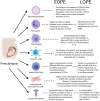Mechanisms of Key Innate Immune Cells in Early- and Late-Onset Preeclampsia
- PMID: 33013837
- PMCID: PMC7462000
- DOI: 10.3389/fimmu.2020.01864
Mechanisms of Key Innate Immune Cells in Early- and Late-Onset Preeclampsia
Abstract
Preeclampsia is a complex cardiovascular disorder of pregnancy with underlying multifactorial pathogeneses; however, its etiology is not fully understood. It is characterized by the new onset of maternal hypertension after 20 weeks of gestation, accompanied by proteinuria, maternal organ damage, and/or uteroplacental dysfunction. Preeclampsia can be subdivided into early- and late-onset phenotypes (EOPE and LOPE), diagnosed before 34 weeks or from 34 weeks of gestation, respectively. Impaired placental development in early pregnancy and subsequent growth restriction is often associated with EOPE, while LOPE is associated with maternal endothelial dysfunction. The innate immune system plays an essential role in normal progression of physiological pregnancy and fetal development. However, inappropriate or excessive activation of this system can lead to placental dysfunction or poor maternal vascular adaptation and contribute to the development of preeclampsia. This review aims to comprehensively outline the mechanisms of key innate immune cells including macrophages, neutrophils, natural killer (NK) cells, and innate B1 cells, in normal physiological pregnancy, EOPE and LOPE. The roles of the complement system, syncytiotrophoblast extracellular vesicles and mesenchymal stem cells (MSCs) are also discussed in the context of innate immune system regulation and preeclampsia. The outlined molecular mechanisms, which represent potential therapeutic targets, and associated emerging treatments, are evaluated as treatments for preeclampsia. Therefore, by addressing the current understanding of innate immunity in the pathogenesis of EOPE and LOPE, this review will contribute to the body of research that could lead to the development of better diagnosis, prevention, and treatment strategies. Importantly, it will delineate the differences in the mechanisms of the innate immune system in two different types of preeclampsia, which is necessary for a more personalized approach to the monitoring and treatment of affected women.
Keywords: early-onset preeclampsia; immune cells; inflammation; innate immunity; late-onset preeclampsia; preeclampsia; pregnancy.
Copyright © 2020 Aneman, Pienaar, Suvakov, Simic, Garovic and McClements.
Figures


Similar articles
-
Comparison of immune-related gene signatures and immune infiltration features in early- and late-onset preeclampsia.J Gene Med. 2024 Feb;26(2):e3676. doi: 10.1002/jgm.3676. J Gene Med. 2024. PMID: 38362844
-
Lipidomic signatures in patients with early-onset and late-onset Preeclampsia.Metabolomics. 2024 Jun 16;20(4):65. doi: 10.1007/s11306-024-02134-x. Metabolomics. 2024. PMID: 38879866 Free PMC article.
-
Oxidative stress and mitochondrial dysfunction in early-onset and late-onset preeclampsia.Biochim Biophys Acta Mol Basis Dis. 2020 Dec 1;1866(12):165961. doi: 10.1016/j.bbadis.2020.165961. Epub 2020 Sep 8. Biochim Biophys Acta Mol Basis Dis. 2020. PMID: 32916282 Review.
-
Telomere Homeostasis and Senescence Markers Are Differently Expressed in Placentas From Pregnancies With Early- Versus Late-Onset Preeclampsia.Reprod Sci. 2019 Sep;26(9):1203-1209. doi: 10.1177/1933719118811644. Epub 2018 Nov 25. Reprod Sci. 2019. PMID: 30474505
-
Preeclampsia and syncytiotrophoblast membrane extracellular vesicles (STB-EVs).Clin Sci (Lond). 2022 Dec 22;136(24):1793-1807. doi: 10.1042/CS20220149. Clin Sci (Lond). 2022. PMID: 36511102 Free PMC article. Review.
Cited by
-
Polymorphism Patterns and Socioeconomic Characteristics and Their Influence on the Risk of Preeclampsia.Medicina (Kaunas). 2024 May 28;60(6):890. doi: 10.3390/medicina60060890. Medicina (Kaunas). 2024. PMID: 38929507 Free PMC article.
-
Setting a stage: Inflammation during preeclampsia and postpartum.Front Physiol. 2023 Feb 23;14:1130116. doi: 10.3389/fphys.2023.1130116. eCollection 2023. Front Physiol. 2023. PMID: 36909242 Free PMC article. Review.
-
Placental neutrophil reverse trans-migration and maternal serum neutrophil extracellular trap expression in HIV infection co-morbid pre-eclampsia in women of African ancestry.Histochem Cell Biol. 2024 Oct;162(4):273-286. doi: 10.1007/s00418-024-02298-6. Epub 2024 Jun 24. Histochem Cell Biol. 2024. PMID: 38913117 Free PMC article.
-
Reproductive Immunology and Pregnancy 2.0.Int J Mol Sci. 2024 May 9;25(10):5132. doi: 10.3390/ijms25105132. Int J Mol Sci. 2024. PMID: 38791171 Free PMC article.
-
Identification and preliminary validation of biomarkers associated with mitochondrial and programmed cell death in pre-eclampsia.Front Immunol. 2025 Jan 23;15:1453633. doi: 10.3389/fimmu.2024.1453633. eCollection 2024. Front Immunol. 2025. PMID: 39916955 Free PMC article.
References
Publication types
MeSH terms
LinkOut - more resources
Full Text Sources

